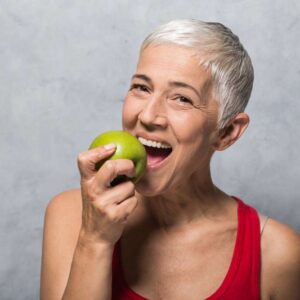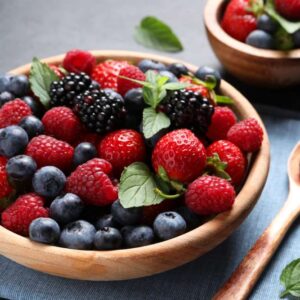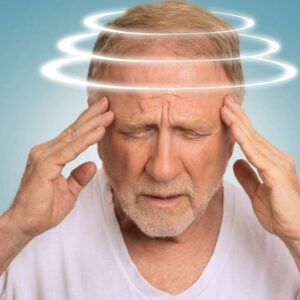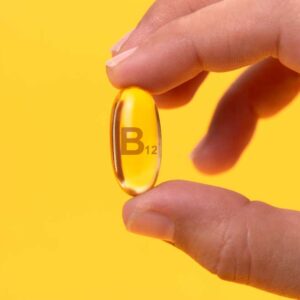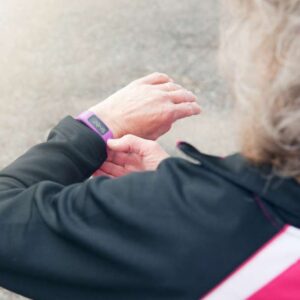
Do This One Simple Thing to Keep Your Joints Younger for Longer
- Discover the age-related changes that make your joints hurt
- This one thing is key to keeping you mobile in your older years. Find out more…
- Three ways to wave goodbye to joint pain and stiffness.
Dear Living Well Daily Reader,
“OOOUUUCCCH! When did getting out of a chair start hurting so much?!?”
A few weeks ago, when I was visiting my family, this is what my dad asked me as he got out of his chair.
Like many folks, my father suffers from joint and muscle stiffness. And while during most of the year he walks about 2–3 miles a day with his loyal walking partner, a dog named Bruce, he’s lucky to get in half a mile during the blazing-hot Florida summer.
It’s in these months that he experiences more pain and stiffness than usual. And as it seems, there is a good reason for this, which I will share in just a bit. Fortunately, there is a solution for my father and anyone else who suffers from chronic joint pain and stiffness.
That’s why we have invited our colleague, Lisa Ball, of Plum Dragon Herbs and Dit Da Jow, to help explain some of the reasons why joint stiffness and pain occur and the best way to help keep your joints younger for longer.
Plus, she will tell you about some amazing, 100 percent natural herbal products that may alleviate joint pain and stiffness.
Take it away, Lisa…
Do This One Simple Thing to Keep Your Joints Younger for Longer
Everyone knows that our bodies change as we age, but what does that look like up close at the joints? And, more importantly, what can we do to keep them younger for longer? We are going to answer these questions for you and tell you about some awesome 100 percent natural herbal products you can use to help heal injuries and pain, and condition joints and connective tissue.
![]() Decreases in Muscle Fibers
Decreases in Muscle Fibers
As you age, there is usually a decrease in the size and number of muscle fibers, especially if you’re sedentary. This causes your remaining muscle tissue to have a slower response time. Almost everyone experiences a noticeable change in their quickness as they approach their 40s and 50s. This puts more stress on the remaining muscle fibers when they try to perform at the same level, and that extra stress raises your risk of strains and pulled muscles.
![]() Lower Cardiac Output
Lower Cardiac Output
The heart’s a muscle too, so when it starts performing at a lower level, less blood is delivered to your muscles and joints for fuel and recovery. You’ll notice that your endurance capacity isn’t what it used to be, and that recovering from strenuous work takes longer. When full recovery takes longer, it’s easier to build up cumulative damage to a point where something tears.
![]() Fluid Loss in Connective Tissues
Fluid Loss in Connective Tissues
At any age, connective tissue has a very low blood supply compared to other tissues, so things like nutrient delivery and recovery time are always fairly slow compared to tissues like muscle and skin.
But as you age, the challenge deepens because there is often an overall loss of water in tendon, ligaments, and cartilage, which makes them lose some of their cushion and flexibility.
This rigidity makes them more vulnerable to stress. So, when you are coming back down from that jump shot in basketball, the Achilles tendon in your heel is not going to provide as much shock-absorbing help and can tear in the process.
Combine lower cardiac output and higher stress, and tendons (which are like fibrous cords that attach muscles to bone) can reach a point where they never have time to fully recover. Damage accumulates until a joint is chronically inflamed.
Ligaments (which connect bone to bone) have an even weaker blood supply than tendons and can be particularly hard to repair when damage accumulates.
Cartilage, which has no blood supply at all, can also suffer the same kind of cumulative damage. Just like ligaments and tendons, it loses its water content, providing less cushion and making it more likely to be damaged when stress is placed on a joint. Constant joint loads can wear it away until signs of arthritis start showing up.
![]() Why Motion and Challenge Are the Answer
Why Motion and Challenge Are the Answer
Physiology experts of all shades, including the American Academy of Orthopedic Surgeons, confirm that the most effective way to slow age-related changes in muscles, ligaments and joints is by remaining active in ways that both stretch and challenge muscles and connective tissue. It’s not just age, but the lack of movement and use of muscles that allow the aging process to speed up.
Even if you’re eating calcium- and vitamin D-rich foods, popping a handful of glucosamine and chondroitin pills and drinking traditional bone broth, you still have to move those joints in order to help all that goodness get to where it can do some good.
Pilates, swimming, yoga and many other forms of exercise that incorporate flexibility simultaneously provide great benefits for joint health. The goal is to keep every part of the joint moving (with appropriate rest in between, of course).
Exercise doesn’t have to be strenuous, but it should be consistent, and it should at least be challenging enough to send the signal to your muscles that they have a reason to stick around.
![]() Liniments Can Extend What Exercise Begins
Liniments Can Extend What Exercise Begins
Certain liniments can have both a healing and conditioning effect on connective tissues and can have dramatic pain-relieving effects:
- If it’s conditioning you’re after, it’s hard to do better than our Ancestors Advanced Dit Da Jow. If you know you need to strengthen a particular area of the body that has been weakened for some time, or if you sustained an injury that has never fully healed, this is the formula for you
- If you’re already dealing with a fresh painful and swollen or bruised injury, Bruise Juice is excellent for helping with the inflammation, redness/bruising and swelling and pain of fresh injuries
- Or, you can get the best of both worlds with Ho Family Dit Da Jow, our best-selling formula known for both its conditioning properties and its ability to reduce pain and accelerate healing from injuries caused by overuse. (Please note this formula is NOT for fresh injuries where bruising and swelling are still present. This formula is best for chronic injury and pain.)
Click here to find out more about the amazing powers of Plum Dragon’s Dit Da Jow!
Lisa Ball
CEO, Plum Dragon Herbs and Dit Da Jow.
As always, check with your doctor before starting a new herbal product.
And let us know if you have used a dit da jow before! Write me at nmoore@lfb.org
Live well,

Natalie Moore
Managing editor, Living Well Daily
Written By Natalie Moore
Natalie Moore is a dedicated health researcher with a passion for finding healthy, natural, and science-based solutions. After a decade of direct healthcare experience in western and natural medicine, she was involved in public health research before joining Living Well Daily.
View More Free Articles
Why Your Muscles Are Your Brain's Best Defense
Forget expensive brain scans and head-scratching cognitive tests that make you feel like you’re back in school. Japanese researchers have stumbled onto something that could change how we screen for memory problems—and it’s so simple, you’ll wonder why nobody thought of it sooner. A quick, painless measurement you can get during a routine checkup might...
Four Carbs that Could Add YEARS to Your Life
You’ve likely been avoiding carbs like the plague. Health gurus, fitness influencers, and diet books have convinced you that carbs are the enemy—that they spike your blood sugar, pack on pounds, and fast-track you to diabetes. So you’ve eliminated bread, sworn off pasta, and feel guilty just touching a piece of fruit. But what if...
Upgrade from Bananas and Apples to These Powerhouse Fruits
I’m often asked which fruits are the best. So, let’s talk about it. I’ll cut right to the chase: berries win this contest hands down. If you’re limiting your options to apples and bananas, you’re missing out on a universe of superior antioxidant power. Those everyday fruits are like bringing a knife to a gunfight...
The REAL Reason Americans are Getting “Fatter”
You’ve heard it a thousand times: “Americans are getting fatter because we’re lazy.” We sit at desks all day. We binge-watch Netflix instead of hitting the gym. We’ve traded physical labor for sedentary lifestyles. It’s a tidy explanation for why obesity has skyrocketed in developed countries. There’s just one problem—it’s completely wrong… A groundbreaking Duke...
Mailbag: Room Won't Stop Spinning? Do THIS First
“I’m dealing with vertigo issues, lightheadedness, and dizziness. As recently as this last Saturday I had multiple occurrences throughout the day. Is there anything I can do for this? I’m 69 and in good health. I work out 4 to 5 times a week.” —Spinning Hi Spinning, When patients approach me with similar complaints, I...
Hidden Number Secretly Sabotages Male Performance
Guys (and gals that love them), we should talk. You know how we’ve always been told that bedroom troubles are just part of getting older—that we just need to live with them? Well, it turns out that’s not true. Scientists recently wrapped up a six-year study that followed over 100 healthy men, and the findings...
Shocking Study Links Kids' Snacks to Dangerous Early Puberty
Kids are growing up in a world vastly different from the one we knew. Back in our day, if a child wanted something sweet, it was a piece of candy or a homemade cookie. Today’s kids are surrounded by products filled with artificial sweeteners that didn’t even exist when we were raising our own children....
Outdated Vitamin Guidelines Put Your Brain at Risk
If you’re like most people, you probably don’t think twice about vitamin B12—until your doctor mentions it during a routine blood test. But new research published in the Annals of Neurology suggests we need to pay closer attention to this crucial nutrient—especially as we age. Turns out, current guidelines for this essential nutrient might be...
The TRUTH About Supplement "Liver Dangers" REVEALED
There’s been a lot of buzz lately about liver damage from supplements—so, let’s talk about it. Reports of supplement-induced liver injuries have some folks wondering, “Could my natural remedy actually be harming me?” But before you toss all your supplements in the trash, let’s separate fact from fear—and talk about how to use supplements safely....
The 10,000 Steps LIE That's Ruining Your Health
I’ll be honest—I’m a little sick of the 10,000-steps theory. You know, the one that insists you need to take at least that many steps daily to stay healthy? You won’t believe where that claim originally came from. The 10,000-steps theory wasn’t handed down from the fitness gods on stone tablets. It originated from a...

